A sculptor is an artist who specializes in sculpture.
Sculptor may also refer to:
A sculptor is an artist who specializes in sculpture.
Sculptor may also refer to:

Fornax is a constellation in the southern celestial hemisphere, partly ringed by the celestial river Eridanus. Its name is Latin for furnace. It was named by French astronomer Nicolas Louis de Lacaille in 1756. Fornax is one of the 88 modern constellations.
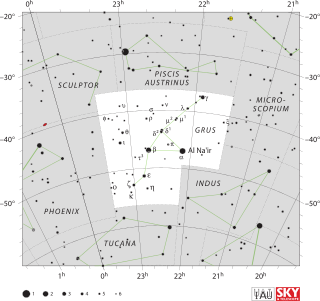
Grus is a constellation in the southern sky. Its name is Latin for the crane, a type of bird. It is one of twelve constellations conceived by Petrus Plancius from the observations of Pieter Dirkszoon Keyser and Frederick de Houtman. Grus first appeared on a 35-centimetre-diameter (14-inch) celestial globe published in 1598 in Amsterdam by Plancius and Jodocus Hondius and was depicted in Johann Bayer's star atlas Uranometria of 1603. French explorer and astronomer Nicolas-Louis de Lacaille gave Bayer designations to its stars in 1756, some of which had been previously considered part of the neighbouring constellation Piscis Austrinus. The constellations Grus, Pavo, Phoenix and Tucana are collectively known as the "Southern Birds".
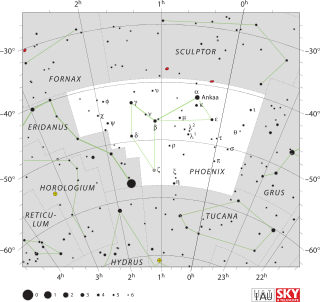
Phoenix is a minor constellation in the southern sky. Named after the mythical phoenix, it was first depicted on a celestial atlas by Johann Bayer in his 1603 Uranometria. The French explorer and astronomer Nicolas Louis de Lacaille charted the brighter stars and gave their Bayer designations in 1756. The constellation stretches from roughly −39° to −57° declination, and from 23.5h to 2.5h of right ascension. The constellations Phoenix, Grus, Pavo and Tucana, are known as the Southern Birds.

Sculptor is a faint constellation in the southern sky. It represents a sculptor. It was introduced by Nicolas Louis de Lacaille in the 18th century. He originally named it Apparatus Sculptoris, but the name was later shortened.
Leo I may refer to:
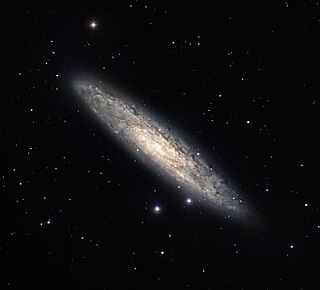
The Sculptor Galaxy is an intermediate spiral galaxy in the constellation Sculptor. The Sculptor Galaxy is a starburst galaxy, which means that it is currently undergoing a period of intense star formation.

A dwarf spheroidal galaxy (dSph) is a term in astronomy applied to small, low-luminosity galaxies with very little dust and an older stellar population. They are found in the Local Group as companions to the Milky Way and as systems that are companions to the Andromeda Galaxy (M31). While similar to dwarf elliptical galaxies in appearance and properties such as little to no gas or dust or recent star formation, they are approximately spheroidal in shape and generally have lower luminosity.
The Canis Major Overdensity or Canis Major Dwarf Galaxy is a disputed dwarf irregular galaxy in the Local Group, located in the same part of the sky as the constellation Canis Major.

The Sculptor Dwarf Irregular Galaxy (SDIG) is an irregular galaxy in the constellation Sculptor. It is a member of the NGC 7793 subgroup of the Sculptor Group. The galaxy was discovered in 1976.

The Sculptor Dwarf Galaxy is a dwarf spheroidal galaxy that is a satellite of the Milky Way. The galaxy lies within the constellation Sculptor. It was discovered in 1937 by American astronomer Harlow Shapley using the 24-inch Bruce refractor at Boyden Observatory. The galaxy is located about 290,000 light-years away from the Solar System. The Sculptor Dwarf contains only 4 percent of the carbon and other heavy elements in our own galaxy, the Milky Way, making it similar to primitive galaxies seen at the edge of the universe.

The Phoenix Dwarf is a dwarf irregular galaxy discovered in 1976 by Hans-Emil Schuster and Richard Martin West and mistaken for a globular cluster. It is currently 1.44 Mly away from Earth. Its name comes from the fact that it is part of the Phoenix constellation.

The Carina Dwarf Spheroidal Galaxy is a dwarf galaxy in the Carina constellation. It was discovered in 1977 with the UK Schmidt Telescope by Cannon et al. The Carina Dwarf Spheroidal galaxy is a satellite galaxy of the Milky Way and is receding from it at 230 km/s. The diameter of the galaxy is about 1600 light-years, which is 75 times smaller than the Milky Way. Most of the stars in the galaxy formed 7 billion years ago, although it also experienced bursts of star formation about 13 and 3 billion years ago. It is also being tidally disrupted by the Milky Way galaxy.
Andromeda III is a dwarf spheroidal galaxy about 2.44 million light-years away in the constellation Andromeda. It is part of the Local Group and is a satellite galaxy of the Andromeda Galaxy (M31). The galaxy was discovered by Sidney van den Bergh on photographic plates taken in 1970 and 1971.
Sagittarius may refer to:
Pisces may refer to:

NGC 247 is an intermediate spiral galaxy about 11.1 Mly away in the constellation Cetus. This distance was confirmed in late February 2011. Previous measurements showed that the galaxy was about 12.2 Mly away, but this was proved to be wrong. NGC 247 is a member of the Sculptor Group, and is 70 000 light years in diameter.
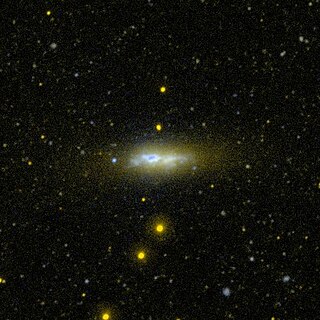
NGC 625 is a dwarf barred spiral galaxy about 12.7 Mly away in the constellation Phoenix. NGC 625 is a member of the Sculptor Group.

NGC 24 is a spiral galaxy in the southern constellation of Sculptor, about 23.8 megalight-years distant from the Milky Way. It was discovered by British astronomer William Herschel in 1785, and measures some 40,000 light-years across. The general shape of this galaxy is specified by its morphological classification of SA(s)c, which indicates it is an unbarred spiral with no ring-like structure and moderate to loosely-wound spiral arms. This galaxy is positioned in the vicinity of the Sculptor Group, but is actually a background object that is more than three times as distant. It may form a pair with another background galaxy, NGC 45.
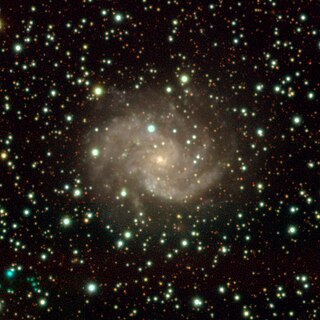
NGC 6215 is a spiral galaxy located in the constellation Ara. It is designated as SA(s)c in the galaxy morphological classification scheme. It was discovered by astronomer John Herschel on 9 July 1836.